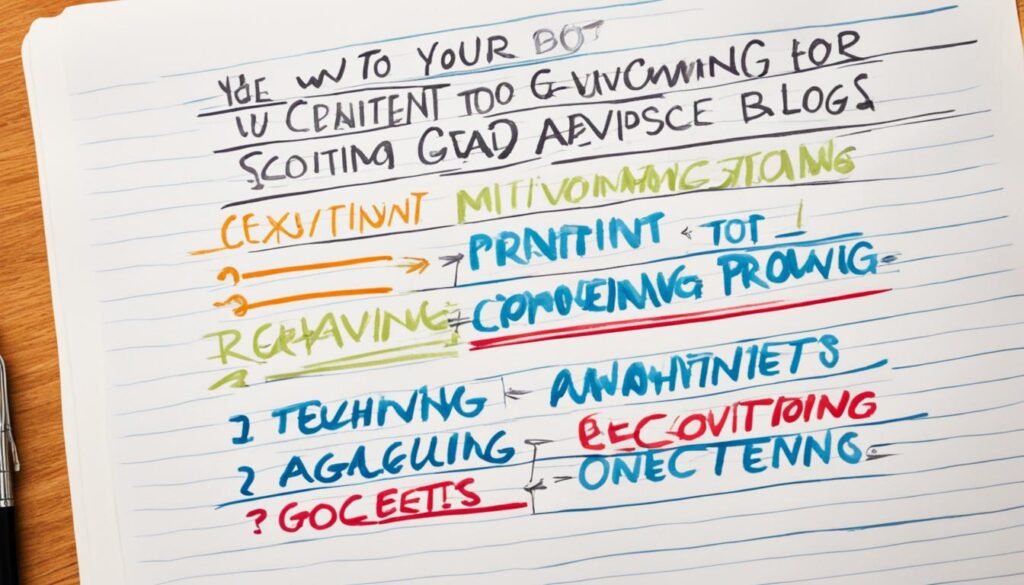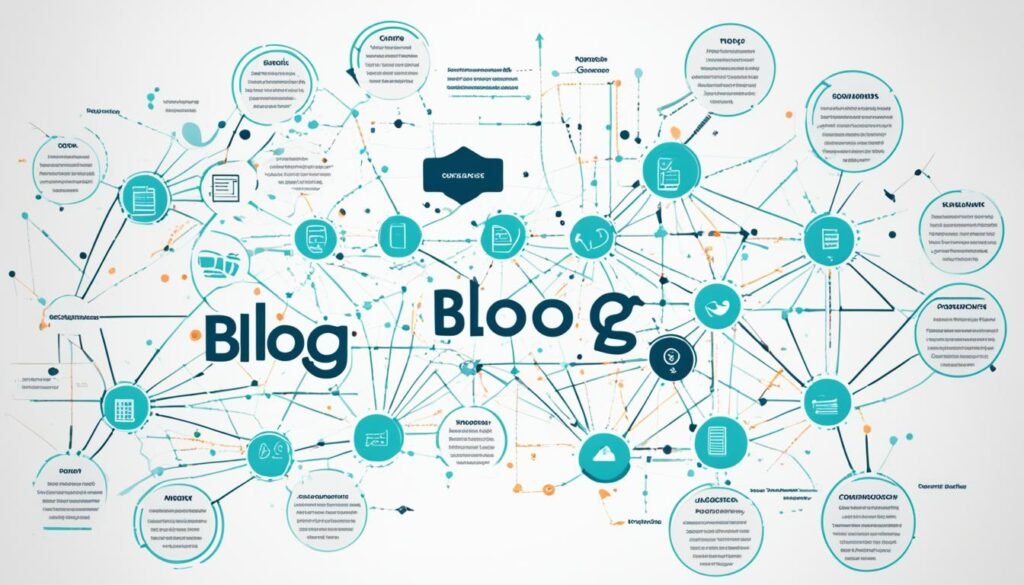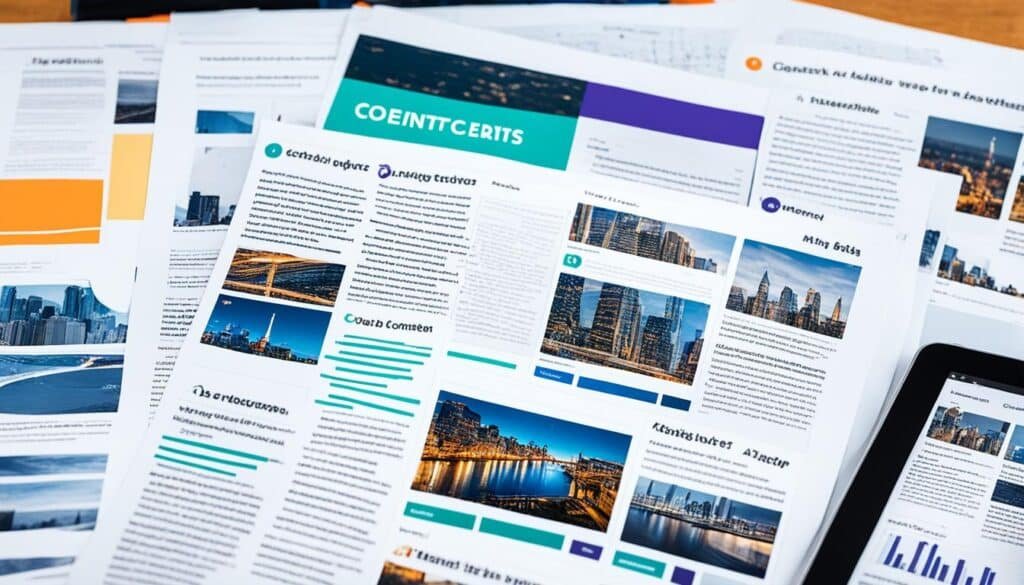Writing blog content is an art that requires skill, strategy, and creativity. Whether you are creating a blog for personal expression or as a marketing tool for your business, understanding the best practices is crucial to attract and engage your audience. In this article, we will delve into the top tips and techniques for crafting compelling blog content.
When it comes to blog writing, there are several key elements to consider. From choosing the right blog post templates to defining your blog topic, each step plays a significant role in producing high-quality content. We will guide you through the process of writing your first blog post, providing you with valuable insights on how to write a good blog post that resonates with your readers.
One of the most important factors in writing a great blog post is understanding your target audience. By analyzing their interests and demographic information, you can tailor your content to their specific needs and preferences. This not only helps to attract readers but also builds long-lasting relationships with your audience.
Throughout this article, we will explore various strategies for optimizing and enhancing your blog content. From conducting thorough topic research to implementing an effective blog structure, these practices will elevate the quality of your blog and improve its performance in search engine rankings.
Ready to take your blog writing skills to the next level? Let’s dive into the best practices that will help you create captivating blog content that stands out and drives results.
Key Takeaways: Writing Blog Content
- Choose blog post templates and define your blog topic to create a cohesive and structured content.
- Understand your target audience’s interests and demographics to tailor your content to their needs.
- Thoroughly research topics and analyze competitors to create valuable and unique blog content.
- Create an effective blog structure using skimmable headlines, bullet points, and white space for readability.
- Optimize your blog content with relevant keywords and maintain an appropriate keyword density.
Define Your Reader Personas
Before writing blog content, it is crucial to define your reader personas. Reader personas help you understand who you are writing for and what information they are looking to get. By knowing your target audience’s demographics, interests, and buying habits, you can tailor your content to meet their specific needs and build trusted relationships with them.
Understanding your reader personas allows you to create content that resonates with your blog readers. By catering to their interests, you provide valuable information that aligns with their preferences. This increases engagement and keeps your target audience coming back for more.
To define your reader personas, start by collecting data on your target audience’s demographics and interests. This includes information such as age, gender, location, and particular areas of interest. Conduct surveys, analyze website analytics, and engage with your blog readers through comments and social media to gain insights into their preferences and challenges.
Segment your audience based on their demographics, interests, and buying habits. For example, if you have an e-commerce blog, you may have reader personas who are interested in high-end luxury fashion, while others prefer affordable and sustainable fashion. These personas will have different interests, preferences, and buying habits, which should shape the content you create for them.
“Defining your reader personas is like building a bridge between your blog and your target audience. It enables you to speak directly to their needs and interests, creating a more meaningful connection.”
Once you have defined your reader personas, it’s important to keep them in mind as you write blog content. Consider their interests, pain points, and preferred writing style. Tailor your content to address their specific needs, providing solutions and valuable insights that resonate with them.
Example of Reader Personas:
| Persona | Demographics | Interests | Buying Habits |
|---|---|---|---|
| Persona 1: Fashion Enthusiast | Female, 25-34, Urban | Fashion trends, styling tips, sustainable fashion | Online shopping, high-end luxury brands |
| Persona 2: Budget Shopper | Male, 18-24, Suburban | Affordable fashion, DIY fashion, shopping hacks | Discount stores, thrift shopping |
Understanding your reader personas enables you to create targeted content that addresses their specific interests and needs. By developing a deep understanding of your target audience, you can produce blog content that resonates with them and builds strong relationships. Building reader personas is an essential step in crafting successful blog posts that attract and engage your ideal audience.
Understand User Search Intent

Understanding user search intent is crucial for creating blog content that resonates with your audience and meets their specific needs. By identifying the search intent behind a user’s query, you can tailor your content to provide them with the information they are seeking. There are four main types of user search intent:
- Informational Search: Users are looking for answers to specific questions or seeking knowledge about a particular topic. They may use terms such as “how to,” “what is,” or “benefits of.” Your content should provide in-depth information and address their queries effectively.
- Navigational Search: Users are looking for a specific website or web page. They already have a destination in mind and use search engines to find the quickest way to reach it. Including clear navigation and relevant links in your content can help users navigate your blog and find the information they need.
- Commercial Search: Users are in the research phase of the buying process. They are looking for information about products or services but haven’t made a final decision yet. Your content should highlight the benefits, features, and unique selling points of your offerings to convince potential customers.
- Transactional Search: Users are ready to make a purchase or take a specific action. They often use terms like “buy,” “order,” or “subscribe.” Your content should provide clear call-to-action buttons and guide users through the conversion process seamlessly.
By understanding these different types of user search intent, you can optimize your blog content to align with their expectations and increase your chances of appearing in relevant search results. This not only improves your organic traffic but also enhances the overall user experience and boosts your blog’s performance.
| Type of Search Intent | Description |
|---|---|
| Informational Search | Users seek answers and knowledge |
| Navigational Search | Users look for a specific website or web page |
| Commercial Search | Users research products or services |
| Transactional Search | Users are ready to make a purchase or take action |
Set Goals for Your Blog Posts

Before diving into writing a blog post, it’s crucial to establish clear goals for your content. Setting goals will help shape your writing strategy and ensure that your blog posts are aligned with your objectives, increasing their effectiveness and impact.
When defining your goals, consider the following key areas:
1. Increase Organic Traffic:
One of the primary goals for your blog posts should be to boost organic traffic to your website. By optimizing your content for relevant keywords and implementing SEO best practices, you can improve your blog’s visibility in search engine results. This increased visibility will drive more organic traffic to your blog, expanding your reach and attracting new readers.
2. Generate Social Media Shares:
Social media shares play a vital role in amplifying the reach and visibility of your blog posts. Set a goal to create content that is captivating and engaging, prompting readers to share it on their social media platforms. This will help increase your blog’s exposure and attract a wider audience, extending your blog’s reach beyond organic search traffic.
3. Improve Overall Blog Performance:
As a blogger, it’s important to continuously assess and improve the performance of your blog. Set goals to track key metrics such as bounce rate, average time on page, and conversion rate. By monitoring these metrics and identifying areas for improvement, you can optimize your blog content and design to enhance the user experience and achieve better overall performance.
By setting concrete and measurable goals for your blog posts, you’ll be able to focus your efforts and measure your progress effectively. This strategic approach will not only drive more traffic and shares but also ensure that your blog content is goal-driven and aligned with your broader marketing objectives.
Now, let’s take a look at an example of how goal setting can impact the success of your blog posts:
| Goal | Key Metrics | Progress |
|---|---|---|
| Increase Organic Traffic | Organic search traffic, keyword rankings | Implemented SEO best practices, resulting in a 20% increase in organic search traffic and several blog posts ranking on the first page of search engine results. |
| Generate Social Media Shares | Number of social media shares, engagement rate | Developed shareable content and utilized compelling visuals, leading to a 50% increase in social media shares and a higher engagement rate. |
| Improve Overall Blog Performance | Bounce rate, average time on page, conversion rate | Implemented a more user-friendly blog design and optimized content structure, resulting in a 15% decrease in bounce rate and a 10% increase in conversion rate. |
Conduct Topic Research

When it comes to writing compelling blog content, thorough topic research is essential. By conducting in-depth research, you can gather valuable insights that will inform your writing strategy and help you create content that resonates with your target audience.
One critical aspect of topic research is keyword analysis. By identifying relevant keywords within your niche, you can optimize your blog content for search engines and increase your visibility in search results. Keyword analysis involves understanding the search volume, competition, and relevance of specific keywords to make informed decisions about the keywords you will target in your blog posts.
Another aspect of topic research is exploring evergreen content ideas. Evergreen content refers to articles or blog posts that remain relevant and valuable to readers over time. By creating evergreen content, you can drive consistent traffic to your blog and establish yourself as a trusted source of information in your industry.
Analyzing your competitors’ strategies is also a crucial part of topic research. By examining what your competitors are writing about, you can identify content gaps and opportunities that you can capitalize on. Understanding the topics your competitors are focusing on can help you create unique and valuable content that sets you apart.
Furthermore, adopting a Content Hub Strategy can be beneficial for organizing your blog posts around specific topics. A Content Hub is a collection of articles and blog posts centered around a core topic or theme. By structuring your blog posts based on this strategy, you establish topic authority for your brand, improve user experience, and encourage visitors to explore more of your related content.
With comprehensive topic research, including keyword analysis, exploring evergreen content ideas, analyzing competitors, and implementing a content hub strategy, you can create blog content that resonates with your audience and drives meaningful engagement.
Continue reading to learn how to craft an effective blog structure that enhances readability and attracts readers.
Craft an Effective Blog Structure

Creating an effective blog structure plays a vital role in engaging readers and improving your blog’s search engine optimization (SEO). By following these key practices, you can enhance the readability and visual appeal of your blog content:
- Use skimmable headlines: Catchy and descriptive headlines help readers quickly understand your blog’s main points. They also make your content more scannable and enticing, increasing the likelihood of readers clicking through to read the full article.
- Break up content with bullet points: Instead of presenting long paragraphs, break up your content into easy-to-digest bullet points. This formatting technique makes it easier for readers to skim through your blog, absorbing information at a glance.
- Incorporate white space: White space refers to the empty areas around text and images. Including ample white space in your blog posts increases readability and prevents your content from appearing cluttered. It gives readers’ eyes a rest, making it easier for them to focus on the key message.
- Utilize a list format: Lists are powerful in capturing readers’ attention and improving the flow of your content. Whether it’s a numbered list or a bulleted list, organizing information in a list format helps readers quickly grasp the key takeaways from your blog post.
Incorporating these principles into your blog structure will make your content more appealing and user-friendly. By optimizing your blog for readability and skimming ease, you can attract more readers and improve the overall performance of your blog.
Effective blog structure enhances the readability and visual appeal of your content.
Optimize Your Blog Content with Keywords

Optimizing your blog content with relevant keywords is crucial for improving search engine visibility. By conducting thorough keyword research, you can identify the most valuable terms and phrases to incorporate into your content. This process involves analyzing search volume, competitiveness, and relevance to ensure you are targeting the right keywords.
When using keywords in your blog posts, it’s important to strike a balance. Keyword stuffing, or excessively repeating keywords, can be detrimental to your SEO efforts. Instead, focus on naturally incorporating your keywords in strategic locations, such as the title, headings, and throughout the body of your content.
Long-tail keywords are particularly valuable for driving targeted traffic to your blog. These longer and more specific keyword phrases can help your content rank higher in search results and attract users who are more likely to engage with your blog. Consider using tools like Google Keyword Planner or SEMrush to identify relevant long-tail keywords for your niche.
Keyword Density
Another important factor to consider is keyword density. Keyword density refers to the percentage of times a keyword appears in relation to the total word count of the content. While there is no exact rule for the ideal keyword density, aim for a natural distribution of keywords throughout your blog post.
“The keyword density should be high enough to signal the topic to search engines, but low enough to maintain readability and flow.”
Remember that quality content still takes precedence over keyword optimization. While keywords are important for SEO, ultimately, your blog should provide valuable and engaging information to your readers. Focus on creating compelling content that resonates with your audience, and use keywords as a tool to enhance visibility and attract organic traffic to your blog.
Write Engaging and Valuable Content

When it comes to writing blog content, it’s crucial to capture your readers’ attention and provide them with value. Engaging and valuable content keeps your audience coming back for more, establishing you as an authority in your niche. To achieve this, consider the following strategies:
- Provide a Unique Perspective: Stand out from the crowd by offering a fresh take on your topic. Share personal experiences, case studies, or research-backed insights to give your readers a new perspective.
- Offer Helpful Information: Provide practical tips, step-by-step guides, or how-to articles that address your readers’ pain points. Be solution-oriented and offer actionable advice that they can implement immediately.
- Use Reader-Friendly Language: Write in a conversational tone, using clear and concise language. Avoid using jargon or technical terms that may confuse your readers. Make your content accessible and easy to understand.
Why Engaging and Valuable Content Matters
“Engaging and valuable content is the key to building a loyal audience. By providing unique perspectives, offering helpful information, and using reader-friendly language, you can create a blog that readers will keep coming back to.” – Jane Smith, Content Marketing Expert
By writing engaging and valuable content, you not only capture your readers’ attention but also establish trust and credibility. When readers find your content helpful and informative, they are more likely to share it with others, increasing your blog’s reach and impact.
To further enhance the reader experience, consider incorporating visual elements into your content. Images, infographics, and videos can help convey information more effectively and make your blog posts more visually appealing.
Remember, the goal is to add value to your readers’ lives. By focusing on creating engaging, insightful, and reader-friendly content, you can build a strong following and establish yourself as a trusted source in your industry.
| Benefits of Engaging and Valuable Content | Example |
|---|---|
| Increased reader engagement | Readers spend more time on your blog, leave comments, and share your content with others. |
| Higher search engine rankings | High-quality content is more likely to be recognized by search engines and rank higher in search results. |
| Establishment of authority | Valuable content positions you as an expert and builds trust with your audience. |
| Greater reader loyalty | When readers find value in your content, they are more likely to become loyal followers and engage with future posts. |
Include Visuals and Media Content

Including visuals and media content in your blog posts can significantly enhance user engagement and make your content more shareable. By incorporating images, videos, and infographics, you can complement your written content and provide additional value to your readers. Visual elements not only break up the text but also make your blog visually appealing and interactive.
Add Captivating Images
Images are a powerful tool that can instantly grab your readers’ attention. Whether it’s a stunning photograph, an eye-catching illustration, or an informative chart, visuals can effectively convey information and evoke emotions. Make sure to include relevant images within your blog posts to make them visually appealing and enhance the overall reading experience.
Embed Engaging Videos
Videos are one of the most engaging forms of media content that you can include in your blog posts. They allow you to present information in a dynamic and interactive way, capturing your audience’s attention and delivering your message effectively. You can embed videos from platforms like YouTube or Vimeo to enhance the multimedia experience of your blog.
Create Informative Infographics
Infographics are an excellent way to present complex information in a visually appealing and easy-to-understand format. They provide a visual summary of facts, statistics, or step-by-step processes, making it easier for your audience to consume and remember the information you’re sharing. Consider creating and including infographics to provide valuable insights and enhance the educational value of your blog content.
Make Use of Multimedia Content
In addition to images, videos, and infographics, there are various other forms of multimedia content you can include in your blog posts. This can include audio clips, interactive elements, slideshows, or even virtual reality experiences. By incorporating different types of media, you can offer a diverse and engaging experience for your readers.
Optimize with Alt Text
When adding visuals to your blog posts, it’s important to include alt text in the img tag. Alt text is a brief description of the image that helps search engines understand the content and improves accessibility for visually impaired readers. Be sure to use descriptive alt text that includes relevant keywords related to the visuals in order to optimize your blog content for search engine rankings.
Internal Linking and Promoting Your Blog Content

Internal linking is a crucial aspect of blog content creation. By strategically linking to other relevant posts and pages within your blog, you can guide readers to explore more of your content and improve the overall user experience. It also helps search engines crawl and index your website more effectively, boosting your SEO efforts.
When implementing internal links, consider the relevance and context of the anchor text. Use descriptive and keyword-rich phrases that accurately represent the linked content. For example, if you’re writing a blog post about on-page SEO techniques, you can include a link to a previous article on keyword research tools, using anchor text such as “best keyword research tools” or “top tools for keyword analysis.”
Additionally, internal linking provides an opportunity to highlight your pillar or cornerstone content. These are comprehensive and authoritative articles that cover a broad range of relevant topics in your industry. By linking to your pillar content from other related blog posts, you can establish your blog as a go-to resource for information in your niche.
Furthermore, promoting your blog content through social media channels is essential for reaching a broader audience. Share your blog posts on platforms such as Facebook, Twitter, LinkedIn, and Instagram, utilizing catchy headlines, relevant hashtags, and engaging visuals to drive traffic back to your blog. Encourage your followers to like, share, and comment on your posts to increase their reach and engagement.
Additionally, consider collaborating with influencers or industry leaders in your niche for social media promotion. Partnering with influencers can expand your reach and attract new followers who are interested in your blog’s content. This can be in the form of guest posts, mentions in their social media content, or collaborations on joint projects.
Another effective strategy for promoting your blog content and boosting SEO is actively seeking backlinking opportunities. Backlinks are external links from other websites that point to your blog. They serve as a vote of confidence and credibility in the eyes of search engines, signaling that your content is valuable and worth referencing.
To acquire backlinks, you can reach out to other bloggers, industry publications, or websites that cover topics related to your content. Offer to contribute a guest post or provide valuable insights that can be referenced by these websites. Building relationships and networking within your niche can open up various backlinking opportunities, improving your blog’s visibility and authority in search engine rankings.
Overall, internal linking, social media promotion, and backlinking opportunities are essential components of a successful blog content strategy. By strategically incorporating these techniques, you can enhance user experience, increase your blog’s visibility, and drive more targeted traffic to your website.
Internal Linking Guidelines
| Guidelines | Description |
|---|---|
| Relevance | Link to content that is relevant to the current topic and provides additional value to readers. |
| Anchor Text | Use descriptive and keyword-rich anchor text that accurately represents the linked content. |
| Pillar Content | Highlight your pillar or cornerstone content by linking to it from other related blog posts. |
In crafting an effective blog, a step-by-step guide is essential to cover all aspects of creating engaging blog content that resonates with your target audience and performs well in search engine results pages. From understanding your target audience to brainstorming topic ideas and writing different types of blog posts, every blog post should be meticulously crafted to grab your readers’ attention and keep them interested.
Begin by outlining your post and conducting research as you write to ensure your blog post meets the expectations of your readers. Use blog writing tips to write compelling body content, incorporating tips to make your post more engaging, such as using a free tool like Grammarly for editing.
Whether you’re writing a how-to guide or a listicle, always put yourself in the reader’s shoes to ensure your post effectively communicates the information or instruction. By following this step-by-step guide, you’ll learn how to give your new blog a chance to succeed by consistently delivering valuable and engaging content that resonates with your audience.
Also Read : Master The Art Of Lifestyle Blogging: Tips And Tricks For Success
Conclusion
In conclusion, effective blog writing involves following a set of best practices to enhance your blog’s performance and attract a larger audience. By implementing these strategies, you can create content that resonates with your target readers and provides value to them.
To start, define your reader personas to understand their demographics and interests. This will help you tailor your content to their specific needs and build trust with your audience.
Additionally, understanding user search intent is crucial for crafting blog posts that meet your readers’ informational needs. Conduct thorough topic research, optimize your content with targeted keywords, and create an engaging blog structure to enhance readability and improve search engine visibility.
Remember, promoting your blog content through social media channels and seeking backlinking opportunities can further increase its visibility and drive traffic to your blog. Continuously analyze and refine your strategies to ensure you are consistently delivering high-quality content that keeps your readers coming back for more.
FAQs
Q: What are the key elements to consider when writing a blog post?
A: When writing a blog post, it’s important to focus on the headline, outline, body content, and meta description. These components will help structure your post and make it engaging for readers.
Q: How can I start writing my first blog post?
A: To start writing your first blog post, you should first choose a blog topic that interests you. Then, create an outline to guide your writing process and ensure your post is well-structured.
Q: What type of blog post should I write?
A: The type of blog post you write depends on your goals and target audience. You can choose from various types such as list posts, how-to guides, case studies, and more.
Q: Why is it important to proofread my blog posts?
A: Proofreading your blog posts is crucial to ensure they are free of errors and convey your message clearly. It helps maintain your credibility as a writer and makes your content more professional.
Q: How can I make sure my blog post is optimized for search engines?
A: To optimize your blog post for search engines, use relevant keywords, write a compelling meta description, and ensure your content is valuable to readers. This will help improve your post’s visibility on search engine results pages.
Q: What are some blog writing tips to improve my content?
A: Some blog writing tips include using a clear and concise writing style, engaging with your audience, incorporating visuals, and promoting your posts on social media. These practices can help enhance the quality of your blog content.
Q: How can I create an effective blog post outline?
A: When creating a blog post outline, start with an introduction, followed by key points or sections, and a conclusion. Make sure each section flows logically and supports your main topic.
Q: What are some best practices for writing a good blog post?
A: Some best practices for writing a good blog post include focusing on a captivating headline, providing valuable content, using a blog post template for consistency, conducting keyword research, and ensuring the post is well-structured.
Q: How can I format my blog post to be more effective?
A: To format a blog post effectively, consider using subheadings, bullet points, and images to break up the content, making it easier to read. Additionally, make sure to utilize meta descriptions and tags for SEO optimization.
Q: What should I consider when writing my first blog post?
A: When writing your first blog post, focus on a topic you are passionate about, conduct thorough research, write a compelling introduction, and ensure your post is tailored to your target audience’s interests.
Q: How can I create an engaging blog post checklist?
A: To create an engaging blog post checklist, include key components such as headline optimization, keyword inclusion, content structure, visual elements, and a call to action to encourage reader interaction.
Q: What are some tips for starting a blog and writing your first post?
A: Some tips for starting a blog and writing your first post include choosing a reliable content management system, brainstorming blog post ideas, setting aside dedicated time for writing, and using tools like Grammarly for proofreading.
Q: How can I ensure my blog post maintains reader interest?
A: To keep readers interested, consider varying your writing style, incorporating different types of blog posts, offering practical tips and advice, and engaging with your audience through comments and social media.
Source Links
- https://www.semrush.com/blog/content-marketing-best-practices/
- https://www.lrswebsolutions.com/Blog/Posts/94/SEOContent-Writing/Blog-Best-Practices/blog-post/
- https://blog.hubspot.com/marketing/how-to-start-a-blog





